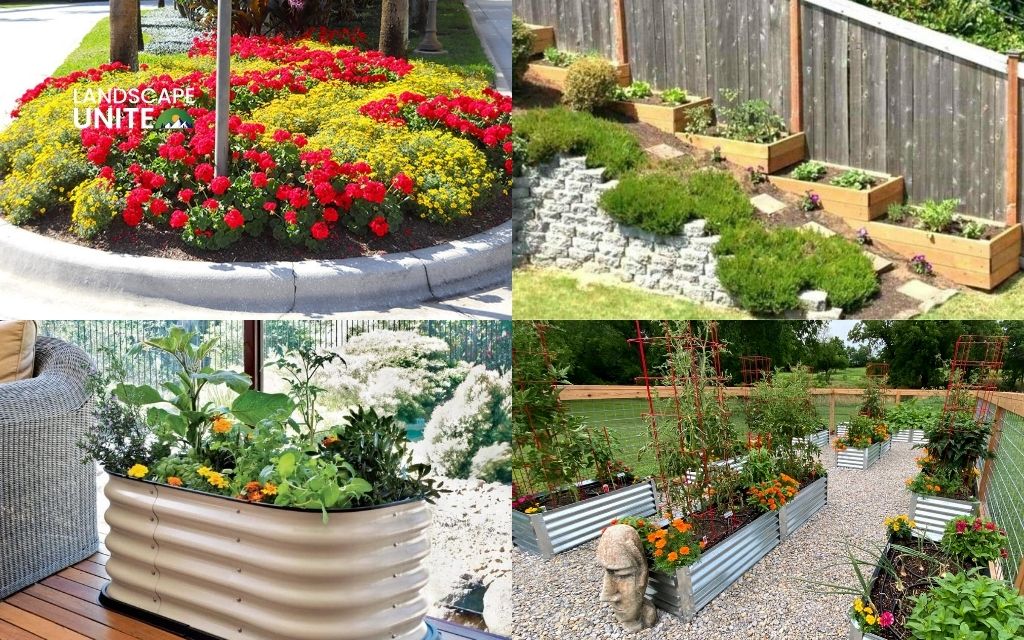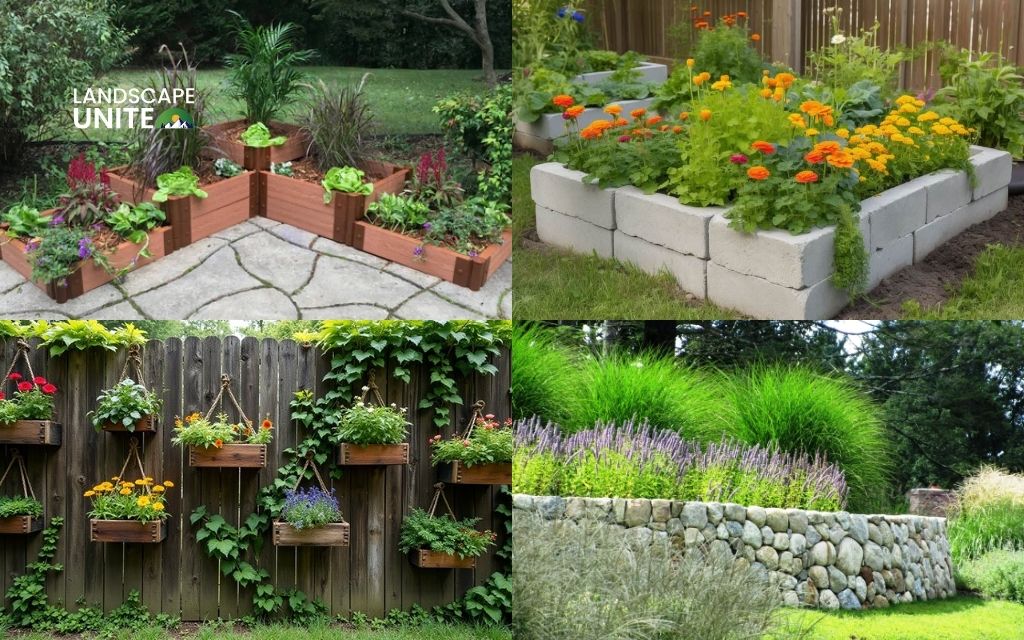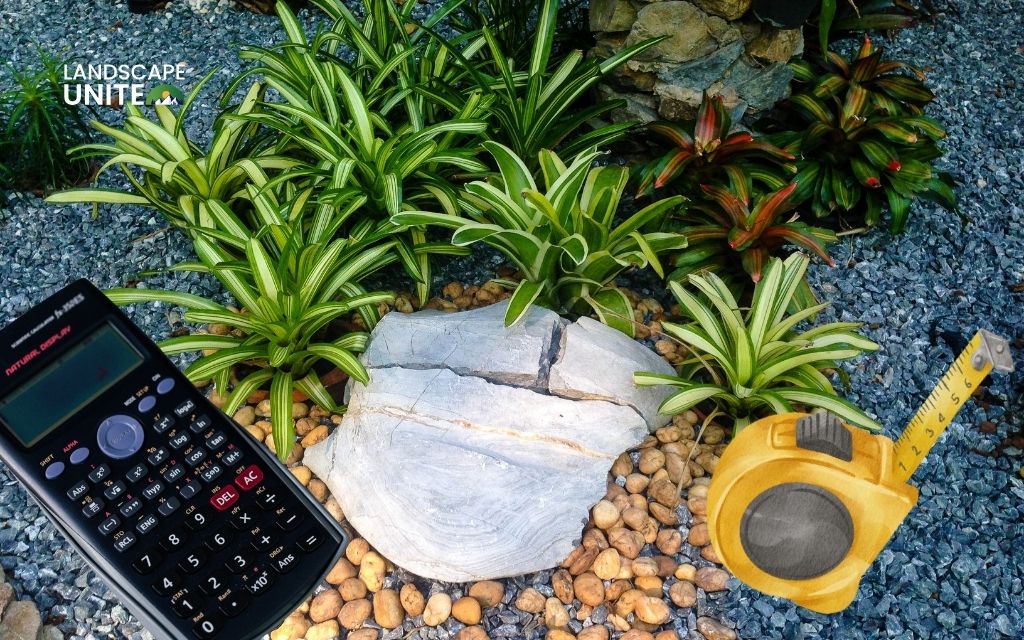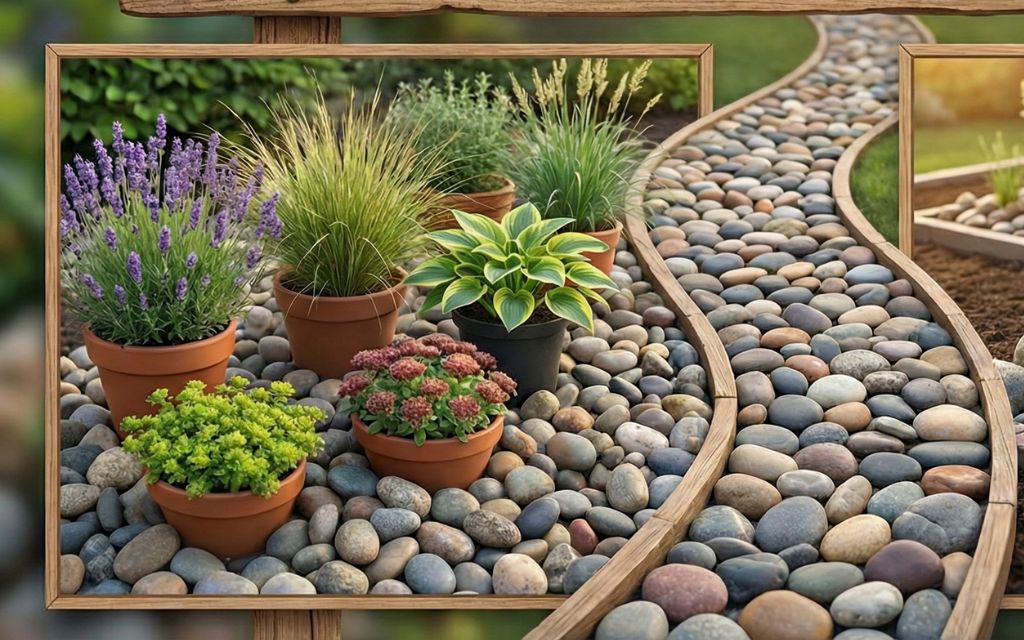Have you ever struggled with poor soil drainage or backaches from bending over traditional garden beds?
Raised flower beds offer superior drainage compared to ground-level planting, preventing root rot and waterlogged soil conditions. The elevated design reduces soil compaction from foot traffic, allowing plant roots to spread freely and access nutrients more efficiently. You’ll also enjoy improved soil quality control since you can customize the growing medium to match your specific flower varieties.
These elevated gardens retain warmth better than traditional beds, extending your growing season and protecting tender plants from temperature fluctuations. Whether you’re working with a small urban patio, dealing with rocky native soil, or simply want easier garden maintenance, raised bed flower garden ideas provide practical solutions for every gardening challenge.
This comprehensive guide shares over 19 creative raised flower bed designs, plus expert plant pairings and building tips to help you create the garden of your dreams.
Discover more:
- 8 foolproof steps to build the raised flower bed of your dreams
- 10 stunning pot-in-flower-bed ideas you’ll want to copy right now
- The ultimate beginner’s guide to trimming flower beds like a pro
- 50 red plants and flowers so striking they’ll steal the spotlight
- 25 front yard plants guaranteed to wow your neighbors
19+ Raised flower bed ideas for every style and yard size
Classic and accessible designs
1. Rectangular wooden raised bed with perennials creates a timeless garden foundation that complements any landscape style. Cedar or redwood construction provides natural weather resistance while maintaining an organic appearance. Fill these beds with low-maintenance perennials like daylilies, black-eyed Susans, and ornamental grasses for year-round beauty. The clean lines work perfectly alongside walkways, patios, or as property border definitions.
2. Brick-lined flower bed bordering a walkway adds elegant structure while guiding visitors through your landscape. This classic approach uses traditional materials that age beautifully and require minimal maintenance over time. Plant colorful annuals like petunias, marigolds, and impatiens for seasonal impact. The brick edging prevents soil erosion and creates crisp, professional-looking boundaries.

3. Cedar raised beds with trellis backdrops for climbing flowers maximize vertical growing space while creating stunning focal points. Install trellises or obelisks within the bed structure to support climbing roses, clematis, or morning glories. This design works exceptionally well against fences, walls, or as standalone garden features. The vertical element adds height variation and creates natural privacy screening.
4. Tiered raised beds for slopes transform challenging hillside terrain into productive growing space. Build multiple levels using retaining materials like stone or timber to create stepped gardens. Each tier can feature different flower varieties based on sun exposure and drainage characteristics. This approach prevents erosion while maximizing planting area on sloped properties.
5. Square bed with rotating seasonal annuals provides flexibility for gardeners who love changing displays throughout the year. Design 4×4 or 6×6 foot beds that accommodate easy replanting and maintenance access. Spring bulbs give way to summer annuals, followed by fall mums and winter evergreen arrangements. The geometric shape fits well in formal garden designs or contemporary landscapes.
Small space and patio-friendly raised bed ideas
6. Mini raised beds with handles for patios or balconies bring gardening to apartment dwellers and small-space enthusiasts. These portable containers feature built-in drainage and mobility for seasonal relocating or winter protection. Fill with compact flowers like violas, dwarf sunflowers, or trailing nasturtiums. The mobility allows you to follow sun patterns or bring plants indoors during harsh weather.
7. Trough-style metal raised beds for narrow yards maximize growing space in challenging urban environments. Galvanized steel or aluminum construction provides durability while the elongated shape fits perfectly along fence lines or building walls. Plant with upright flowers like snapdragons, delphiniums, or foxgloves to create vertical interest. These beds work exceptionally well for creating living privacy screens.
8. Corner-layered raised beds for tight spaces utilize often-overlooked areas where two structures meet. Build L-shaped or curved beds that follow natural architectural lines while softening hard edges. Combine different height levels to create visual depth and accommodate various root system requirements. Fill with shade-tolerant options like hostas, coral bells, or begonias in partially covered areas.
9. Wall-mounted or fence-hanging raised flower boxes create garden space without using ground area. Attach sturdy brackets to existing structures and ensure proper drainage through bottom holes. Choose lightweight growing mediums and compact flowering varieties like lobelia, alyssum, or trailing petunias. This vertical approach works perfectly for rental properties or areas with limited soil access.
10. Repurposed crates or boxes as compact raised beds offer budget-friendly solutions for beginning gardeners. Wine crates, wooden shipping boxes, or even large planter boxes can serve as instant raised bed containers. Line with landscape fabric to prevent soil loss while maintaining drainage. Fill with herb and flower combinations like lavender, rosemary, and colorful annuals for functional beauty.

Stone and rock-based raised beds
11. Dry-stacked stone flower bed with ornamental grasses creates natural-looking borders that blend seamlessly with landscape hardscaping. Use local fieldstone, river rock, or quarried stone to build walls without mortar for easy modification. Plant with native grasses like fountain grass, blue fescue, or feather reed grass combined with wildflowers. This low-maintenance approach requires minimal watering once established and provides habitat for beneficial insects.
12. Circular lava rock raised bed with pollinator plants offers unique texture and color variation while supporting local ecosystems. The porous lava rock provides excellent drainage and thermal mass for temperature regulation. Fill with bee-friendly flowers like coneflowers, bee balm, and native asters to attract butterflies and pollinators. The circular design creates natural gathering spots and works well as garden focal points.
13. Flagstone-rimmed raised bed with mulch interior combines elegant stone edging with practical growing conditions. The flat stone surface provides seating opportunities while defining clean bed boundaries. Use decorative mulch like shredded cedar or cocoa hulls to suppress weeds and retain moisture. Plant with moisture-loving perennials like astilbe, Japanese painted ferns, or bleeding hearts in partially shaded locations.
14. Retaining wall converted into a raised flower bed transforms necessary hardscaping into beautiful growing space. Add soil behind existing walls or build new terraced structures using interlocking blocks or natural stone. These substantial constructions can support larger perennial shrubs like hydrangeas, roses, or flowering bushes. The height variation creates dramatic landscape interest while solving drainage or erosion issues.
Find out more about rock landscapes:
7 lava rock landscaping ideas that will completely transform your yard
16+ eye-catching ways to use rocks in your front yard landscaping
8 best rock types you need to know
Creative and sustainable DIY concepts
15. Pallet wood raised flower bed provides an eco-friendly option using reclaimed materials. Sand and seal wooden pallets to prevent splinters while maintaining rustic charm. Stack and secure pallets to create custom heights and configurations. Fill with wildflower mixes, cottage garden favorites, or cutting garden varieties for sustainable beauty. This approach works perfectly for temporary growing situations or rental properties.
16. Concrete block raised bed with inset herb pockets combines vegetable gardening with ornamental plantings. The hollow blocks can house small herb plants like thyme, oregano, or trailing rosemary while the main bed supports larger flowering specimens. This design provides excellent thermal mass for season extension and creates interesting textural contrasts. Paint or stain blocks to match your home’s exterior colors.
17. Repurposed galvanized tubs as flower containers bring farmhouse charm to modern gardens while recycling vintage materials. Old washtubs, feed troughs, or large buckets create instant raised beds with built-in drainage capabilities. These moveable containers work perfectly for renters or gardeners who like to rearrange their displays seasonally. Plant with cottage garden flowers like zinnias, cosmos, and sweet peas for an authentic country appeal.
18. Raised bed with built-in seating and flower edging maximizes functionality while creating comfortable outdoor living spaces. Build wider bed walls that double as bench seating using weather-resistant materials like cedar or composite decking. The integrated design encourages garden interaction and provides rest spots during maintenance activities. Surround with fragrant flowers like lavender, roses, or jasmine for sensory appeal.
19. Living wall raised bed combining flowers and edibles creates productive vertical growing space perfect for small yards or urban environments. Install trellis systems or pocket planters along raised bed backs to support climbing vegetables and flowering vines. Combine productive plants like cherry tomatoes and pole beans with ornamental climbers like sweet peas or morning glories. This approach maximizes harvest potential while maintaining aesthetic appeal.
20. Kids’ butterfly garden bed from upcycled materials teaches environmental stewardship while creating magical outdoor spaces. Use recycled tires, old boots, or colorful containers to build child-height raised beds perfect for small hands. Plant with butterfly-attracting flowers like zinnias, marigolds, and pentas that bloom reliably and tolerate enthusiastic young gardeners. Include native milkweed species to support monarch butterfly populations.
Planning your raised flower bed: What to know first
Ideal bed depths for flowers typically range from 8 to 12 inches, though deeper construction benefits plants with extensive root systems. Annual flowers thrive in 8-inch depths, perennials and small shrubs prefer 10 to 12 inches of growing medium. Consider your target plant varieties when determining construction specifications, as inadequate depth limits root development and plant health.
Best soil mix for raised beds combines equal parts quality loam, compost, and organic matter like aged manure or leaf mold. This blend provides excellent drainage while retaining adequate moisture for healthy plant growth. Avoid heavy clay soils or pure sand, as these extremes create challenging growing conditions. Purchase soil mixes specifically formulated for raised bed gardening, or create your own using locally sourced materials.
Sunlight and microclimate considerations significantly impact flower selection and bed placement decisions. Most flowering plants require 6 to 8 hours of direct sunlight for optimal bloom production and disease resistance. Observe your yard throughout growing seasons to identify sun patterns, wind exposure, and moisture retention areas. Position beds to maximize favorable conditions while protecting tender plants from harsh afternoon sun or strong prevailing winds.
Water efficiency with drip irrigation or soaker hoses reduces maintenance time while promoting healthy root development. Install irrigation systems before filling beds with soil to avoid disturbing established plantings. Drip systems deliver water directly to root zones, reducing evaporation and preventing foliar diseases. Timer controls automate watering schedules, ensuring consistent moisture levels even during busy periods or vacation absences.
Avoid overheating by choosing light-colored materials in full sun locations where intense afternoon heat can damage plant roots. Dark materials like black plastic or metal absorb solar energy, creating excessive soil temperatures that stress plants and increase water requirements. Light-colored stone, painted wood, or composite materials reflect heat while maintaining attractive appearances. Consider partial shade structures during extreme summer months in hot climate regions.
Choosing the right flowers for raised beds
Full sun favorites
Black-eyed Susan, salvia, yarrow, and blanketflower thrive in hot, sunny conditions while providing season-long color with minimal care requirements. These hardy perennials tolerate drought conditions once established and attract beneficial pollinators throughout their extended bloom periods. Black-eyed Susans produce cheerful yellow flowers from summer through fall, while salvias offer spiky blue, purple, or red blooms that butterflies adore.
Yarrow develops feathery foliage topped with flat flower clusters in colors ranging from white and yellow to pink and red varieties. Blanketflower produces daisy-like blooms with distinctive orange and red patterns that brighten sunny borders from spring through frost. These reliable performers return year after year with minimal input while providing excellent cut flower material.
Partial shade options
Coral bells, columbine, and astilbe excel in areas receiving morning sun and afternoon shade, creating colorful displays in challenging growing conditions. Coral bells produce attractive foliage in colors ranging from lime green to deep purple, topped with delicate flower spikes in spring and early summer. The leaves provide season-long interest even after flowers fade.
Columbine develops distinctive spurred flowers in blue, purple, pink, white, and bicolor combinations during late spring and early summer months. These short-lived perennials self-seed readily, creating natural colonies over time. Astilbe produces feathery plumes in white, pink, or red shades above fern-like foliage, preferring consistently moist soil conditions.
Pollinator picks
Bee balm, coneflower, and milkweed support local ecosystem health while creating vibrant garden displays that attract butterflies, bees, and hummingbirds throughout growing seasons. Bee balm produces tubular flowers in red, pink, purple, or white that hummingbirds find irresistible, while the aromatic foliage deters pest insects naturally.
Purple coneflower develops prominent central cones surrounded by drooping petals in purple, pink, white, or yellow varieties. These drought-tolerant natives bloom for months while providing seed heads that feed birds during winter months. Native milkweed species support monarch butterfly reproduction cycles while producing fragrant flower clusters in orange, pink, or white.
Low-maintenance perennials
Sedum, daylilies, and penstemon require minimal care once established while providing reliable performance in various growing conditions. Succulent sedums store water in fleshy leaves, making them perfect for dry locations or water-wise gardening approaches. Fall-blooming varieties like ‘Autumn Joy’ provide late-season color when many other flowers are declining.
Daylilies produce trumpet-shaped flowers in numerous colors and patterns, with each bloom lasting one day but plants producing multiple buds for extended flowering periods. These adaptable perennials tolerate various soil conditions while requiring division only every few years. Penstemon develops tubular flowers attractive to hummingbirds in colors including red, pink, purple, and white.
Pro tip: Combine plants with varied bloom times and textures to create dynamic displays that provide interest throughout growing seasons. Early spring bulbs transition to late spring perennials, followed by summer annuals and fall-blooming asters or chrysanthemums. Layer plants by height with tall background specimens, medium-height focal points, and low-growing edge plants for professional-looking results.
Tips for building and maintaining raised flower beds

Best time to build falls during early spring or fall when moderate temperatures make
Before planting seasons. Spring construction enables immediate planting with summer flowering results, while fall building allows soil amendments to integrate over winter months. Avoid construction during extreme weather periods when materials may be difficult to work with or soil conditions are poor.
- Use untreated cedar, stone, or durable materials that resist decay without introducing harmful chemicals into growing environments. Cedar contains natural preservatives that prevent rot and insect damage while maintaining attractive appearances for many years. Natural stone provides permanent construction with excellent thermal mass properties, though initial costs may be higher than wood alternatives.
- Avoid pressure-treated lumber containing chemicals that may leach into soil and affect plant health or safety. Composite decking materials offer durability similar to treated wood without chemical concerns, though costs typically exceed cedar options. Consider local material availability and your specific climate conditions when selecting construction materials.
- Refresh soil annually with compost to maintain optimal growing conditions and replace nutrients removed by plant growth and harvesting activities. Add 2 to 4 inches of quality compost each spring, working it gently into existing soil without disturbing established root systems. This practice improves soil structure, increases water retention, and provides slow-release nutrition for sustained plant health.
- Monitor soil pH levels annually using simple test kits, adjusting with lime or sulfur as needed to maintain optimal ranges for your chosen plant varieties. Most flowering plants prefer slightly acidic to neutral soil conditions between 6.0 and 7.0 pH levels.
- Mulch or rock top layer retains moisture, suppresses weeds, and provides finished appearances while reducing maintenance requirements. Organic mulches like shredded bark, cocoa hulls, or compost break down over time to improve soil structure, though they require annual renewal. Inorganic options like decorative gravel or river rock provide permanent solutions that complement stone or contemporary bed designs.
Apply mulch layers 2 to 3 inches deep, keeping materials away from plant stems to prevent moisture-related diseases and pest problems. Consider seasonal mulch changes using materials like fall leaves or evergreen boughs for winter protection in harsh climate regions.
Conclusion
Raised flower bed ideas offer practical solutions for common gardening challenges while creating beautiful focal points that enhance your property’s curb appeal and value. The improved drainage, soil control, and easier maintenance make gardening more enjoyable and successful for beginners and experienced enthusiasts alike.
Start small with one or two basic raised bed designs to build confidence and experience before expanding your garden vision. Mix creativity with function by incorporating seating, trellises, or irrigation systems that serve multiple purposes while maximizing your investment in materials and time.
Whether you choose simple wooden rectangles filled with colorful annuals or elaborate stone constructions supporting perennial gardens, raised beds provide the foundation for sustainable gardening success. The elevated growing environment protects your plants while protecting your back, making garden maintenance a pleasure rather than a chore.
Ready to create your dream garden? Landscape Unite provides the best information about landscaping, hardscaping, gardening, and tools for everyone, brought to you by Mile High Lifescape. Subscribe to our blog for more great tips and discover new posts that will transform your outdoor space into a beautiful, functional landscape you’ll love for years to come.
FAQs about raised flower bed ideas
What do you put in the bottom of a raised flower bed?
Place gravel, cardboard, or landscape fabric at the bottom to improve drainage and block weeds from growing up into your flower bed. This foundation layer prevents water from pooling while stopping unwanted vegetation from competing with your flowers.
What flowers grow best in a raised bed?
Perennials like coneflowers and black-eyed Susans, annuals such as zinnias and marigolds, and pollinator-friendly species adapted to your sunlight conditions perform exceptionally well in raised beds. Choose varieties that match your specific sun exposure and climate zone for best results.
What is the cheapest way to make raised flower beds?
Use recycled wood pallets, repurposed containers, or salvaged materials like old tires or shipping crates. These budget-friendly options provide immediate growing space while reducing waste and construction costs significantly.
How deep do raised flower beds need to be?
Most flowers thrive in beds 8 to 12 inches deep, though deeper construction benefits plants with extensive root systems like roses or larger perennials. Annual flowers typically succeed in 8-inch depths, while established perennials prefer 10 to 12 inches of growing medium.
What not to put in a raised garden bed?
Avoid treated lumber that may leach chemicals, compacted clay soil that restricts drainage, or materials like concrete or plastic that prevent proper water movement. These elements can harm plant health and create challenging growing conditions that reduce your gardening success.


